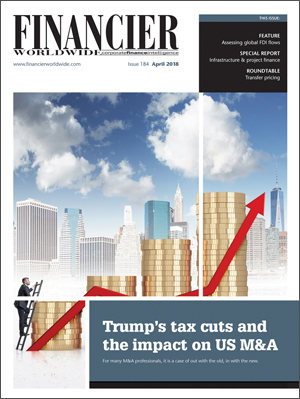The importance of reputation in M&A
April 2018 | PROFESSIONAL INSIGHT | MERGERS & ACQUISITIONS
Financier Worldwide Magazine
A number of reports, including Deloitte’s M&A 2018 trends report and Allen & Overy’s M&A Insights for Q4 2017, have predicted that mergers and acquisitions (M&A) will be at an all-time high in 2018 despite some high-profile recent failures – Kraft Heinz’s failed bid for Unilever to name but one.
According to Allen & Overy, global M&A markets have continued to defy expectations, as they weather a barrage of political and economic woes. The report points out that even though values may have fallen, partly as a result of fewer high-value megadeals, the volume of deals is powering ahead among mid-market transactions. Any organisation that happens to be considering a merger or an acquisition will no doubt be aware of the careful planning and coordination that is required to make a deal successful.
When considering a transaction, mid-way through or even post completion, it is not all about number crunching; reputation plays a key role in the success of the deal. This article will look at best practice in relation to an organisation’s reputation management during the life cycle of an M&A transaction.
Let us begin by looking at what the nature of an organisation’s reputation actually is. Reputation is, many argue, a social phenomenon. Reputation sits at the heart of an organisation. It is the collective thoughts and feelings of the organisations’ stakeholders – employees, shareholders, investors, customers and media, etc. – and results from the accumulated actions, behaviours and decisions of the people within it and how these are perceived. Reputation may not be a tangible asset but it is at the core of any successful organisation.
A strong and positive reputation equates to long-term value and is detected by confidence in the brand, intellectual capital, sustained earnings and, importantly, future growth. According to a Forbes survey in 2015, it can take up to five years for an organisation to recover from a reputational crisis, highlighting the argument that reputation is indeed one of an organisation’s most important assets.
Anybody who has ever been involved in M&A activity, whether that is at top of an organisation, at chief executive, board director and partner level, or at the bottom, such as a janitor or trainee, or on the outside, such as a journalist or consumer, will tell you that the process is nerve-racking and fuelled by gossip. While each stakeholder may have different concerns – will it be successful? Will I lose my job? Will the product or service stay up to standard? – each is as valid as the next and this in itself can trigger a reputational crisis if not managed from the very beginning.
Communicating a merger or acquisition to employees, investors and other stakeholders within the organisation before any contract is signed may not always be a viable option and may create distrust. It is important to remember that M&A is a fast-moving story and that the rumour mill begins turning way before anything is set in motion. Rumours fly internally and externally, so it is crucial to have a communications plan in place to discuss, as openly as possible, any issues that may affect these stakeholders, as soon as is legitimately feasible.
One of the worst things that could happen to an organisation is that the press picks up the story and runs with it before employees have been told that an M&A transaction is being considered, let alone underway. Timing here is crucial, as is the messaging. Many employees will be worried about their job security, so it is vital to ensure that any communication reflects any potential benefits for employees as a result of the success of the deal. Also worth noting is that the more open and transparent the organisation, the better its reputation for trust and therefore the easier it is to quash any malicious rumours floating around.
The external messaging here is also crucial to the success of the deal. It is paramount that both organisations’ reputations stay intact during this often volatile and frenzied transition. The more open organisations are to their public through the media, the better their reputation among the journalists writing about them. If the organisations are liked by those dissecting every inch of the deal, negative pieces are less likely to be written about them. It will also be easier to dispel any untruths, exaggerations and negativity blowing around newsrooms.
The internal shape and structure of the company is not the only change to occur during a merger or an acquisition. In many cases there is an overhaul of one or both of the brands. A complete rebrand needs careful and strategic planning, which should include a carefully-drafted communication plan. It is important that the loyal client base stays loyal. Brand loyalty comes from gaining a strong reputation among clientele, and this must be upheld. The client base needs to understand the reasons behind the rebrand and still be able to recognise their chosen and respected organisation by the end of it. Communication here is key.
In conclusion, the way in which an organisation presents itself during the build-up to a major transaction is crucial. Organisations are operating in an increasingly challenging and uncertain environment, with global and volatile markets, greater regulation, constantly-changing technology and an instant news agenda. As businesses are pushed into the spotlight and subjected to a higher level of scrutiny, the risks and challenges are exacerbated. However, turning this on its head, it also means that a golden opportunity to reach a wider audience has been presented and should not go unused.
Against this often unforgiving backdrop, organisations should invest in a strategically-defined approach to communicating their story both internally and externally, to ensure an unwaveringly strong reputation among all stakeholders.
Giselle Daverat is the founder of GD Consulting. She can be contacted on +44 (0)741 537 6440 or by email: giselle@gd-consulting.com.
© Financier Worldwide
BY
Giselle Daverat
GD Consulting

